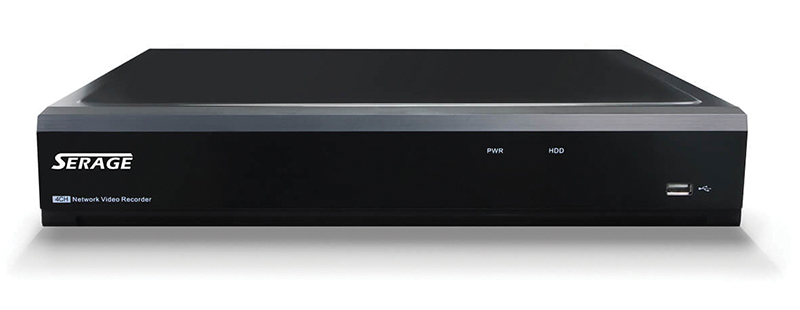 The network video recorder is supplied as a 1TB unit supporting up to four PoE cameras. It includes a range of AI based detection capabilities when used with compatible cameras. It is one of a range of recorders providing from four to sixty-four channels and capable of recording at 4k resolution.
The network video recorder is supplied as a 1TB unit supporting up to four PoE cameras. It includes a range of AI based detection capabilities when used with compatible cameras. It is one of a range of recorders providing from four to sixty-four channels and capable of recording at 4k resolution.
Getting started
The single power supply outputs 48v DC to power the NVR and provide PoE power through the four camera LAN RJ45 ports. It has a maximum power rating of 57.6W.
At first power-up the NVR checks the HDMI monitor is capable of handling 1080p signals and if so gives you the option to change the output resolution. There is a timed save period in case of incompatibility. This is then followed by the initial screen to set a suitable password. An unlock pattern option is also accessible.
Once set the basic login screen is shown with a drop-down language selection.
The NVR then presents a Wizard to assist with establishing the basic setup. This starts with DHCP default IP settings and port information. The next screen is for Date & Time where the date format and time zone must be entered. NTP server details and Daylight-Saving start and end times can be entered from additional page tabs.
The IP Camera page then identifies any Serage cameras connected to the four ports. Alternative or network connected cameras can also be manually added at this point. Next the Disk wizard show the current drive and its capacity and allows formatting to be undertaken once password confirmation is given.
After a final output resolution option, the wizard shows an information screen with a QR code for mobile connection.
Rear panel connectors are from left to right; 4-pin Din power in, 9-pin push-fit alarm & RS485, phono audio out, VGA, HDMI, USB x 2, RJ45 network, and 4 x RJ45 PoE enabled LAN connectors. Above the row of connectors is a power switch to the left and an e-SATA connection to the right. The 9-pin connector is arranged as 4 sensor inputs with ground, relay output, and 2 wire RS485. The PCB allows for an additional 4 sensor inputs and extra camera connection for the 8-channel version.
Audio output from suitable cameras can be taken from the phono socket to an amplifier or is available via the HDMI link.
This unit was fitted with a 1TB Toshiba S300 Surveillance drive, and while there is only space and connectivity for a single drive in this model, larger capacity drives of up to 8TB can be fitted.
Operation
The NVR can be operated as a stand-alone device using a mouse and the HDMI monitor output. The IP address can be identified from the System / Information menu option for network browser connection.
With Serage cameras connected to the four PoE ports the cameras will be identified and connected. These ports use a specific address range from 10.10.25.100 with the first camera starting at address 10.10.25.151. The cameras use a simple password but are effectively isolated from the outside world by the NVR. The camera passwords can be changed but the NVR will expect the simple passwords to be in place if the power is cycled so any alternative password cameras will disappear from the system.
ONVIF compatible cameras can be used if network connected, the connection details are entered using the connection menu and images can be confirmed. The NVR’s on-screen menu has a limited special character set that does not include characters such as #, so it is important to ensure that any such cameras use a password that can be accessed using this on-screen keyboard.
The system is programmed to invoke a system reset every Sunday just after midnight and this was found to involve a full system reset at approximately 2 minutes after midnight with cameras being offline for approximately one and a half minutes. Any PoE cameras that do not conform to the username and password defaults would cease recording from this point. This feature can be modified or turned off using the System / Maintenance /Auto Reboot function.
It was also found that the switch mode on the Setup / Channel menu must be set to “Manual” to ensure network connected cameras recovered from such a system reset.
Very short timeouts are set for menu and browser connections, but these can be increased or made permanent if required.
The Maintenance menu allows all system logs to be searched and exported in csv format.
Read the full review in the February 2023 edition of PSI magazine


